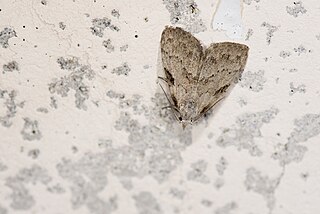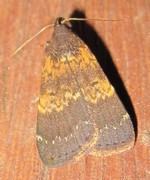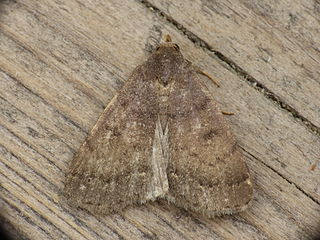Related Research Articles

Digama is a genus of moths in the family Erebidae described by Frederic Moore in 1858. It is distributed in South Africa, China, throughout India, Sri Lanka, Myanmar and Australia.

Nudaria is a genus of moths in the subfamily Arctiinae erected by Adrian Hardy Haworth in 1809.

Manoba is a genus of moths in the family Nolidae. The genus was first described by Francis Walker in 1863.
Anachrostis is a genus of moths of the family Erebidae.

Arsacia is a monotypic moth genus of the family Noctuidae. Its only species is Arsacia rectalis. Both the genus and species were described by Francis Walker, the genus in 1866 and the species in 1863. It is found from the Indo-Australian tropics of India, Sri Lanka to Queensland and the Solomon Islands.
Cingalesa is a monotypic moth genus of the family Noctuidae. Its only species, Cingalesa strigicosta, is found in Sri Lanka. Both the genus and species were first described by George Hampson, the genus in 1894 and the species in 1893.
Ilyrgis is a genus of moths of the family Noctuidae first described by Francis Walker in 1859.

Episteme is a genus of moths of the family Noctuidae. The genus was erected by Jacob Hübner in 1820. Species are widespread.
Holocryptis is a genus of moths of the family Noctuidae erected by Thomas Pennington Lucas in 1893.

Hydrillodes is a genus of litter moths of the family Erebidae first described by Achille Guenée in 1854. Its validity is somewhat disputed.
Hypenagonia is a genus of moths of the family Erebidae first described by George Hampson in 1893. The adult moths have pale brown wings with a dark band across each wing. The wingspan of these moths is about 1 centimeter.
Niaccaba is a monotypic moth genus of the family Noctuidae first described by Francis Walker in 1866. Its single species, Niaccaba sumptualis, described by the same author one year earlier, is found in Sri Lanka, the Ryukyu Islands and Borneo.

Nodaria is a genus of moths in the family Erebidae described by Achille Guenée in 1854.

Nonagria is a genus of moths of the family Noctuidae first described by Ferdinand Ochsenheimer in 1816.
Olulis is a genus of moths of the family Noctuidae first described by Francis Walker in 1863.
Oxygonitis is a monotypic moth genus of the family Noctuidae. Its single species, Oxygonitis sericeata, is found in the Indian subregion, Myanmar, Sumatra, Peninsular Malaysia, Java, Borneo, the Philippines, Sulawesi, Australia and Sri Lanka. Both the genus and species were first described by George Hampson in 1893.
Raparna is a genus of moths of the family Erebidae.

Sphetta is a genus of moths of the family Noctuidae first described by Francis Walker in 1865.
Toxophleps is a genus of moths of the family Noctuidae erected by George Hampson in 1893. The species are transferred in to Tarache. The Global Lepidoptera Names Index and Lepidoptera and Some Other Life Forms describe this genus as a synonym of Cophanta.
Naranga diffusa, the rice green semilooper, is a moth of the family Noctuidae. The species was first described by Francis Walker in 1865. It is found in many agricultural based countries such as Bangladesh, India, Sri Lanka, China, Hong Kong, Iran, Japan, the Korean Peninsula, Malaysia, Myanmar, the Philippines, Thailand, Taiwan and Vietnam.
References
- ↑ Hampson, G. F. (1894). The Fauna of British India, Including Ceylon and Burma: Moths Volume II. Taylor and Francis – via Biodiversity Heritage Library.
- Pitkin, Brian & Jenkins, Paul. "Search results Family: Noctuidae". Butterflies and Moths of the World. Natural History Museum, London.
| This Eustrotiinae article is a stub. You can help Wikipedia by expanding it. |